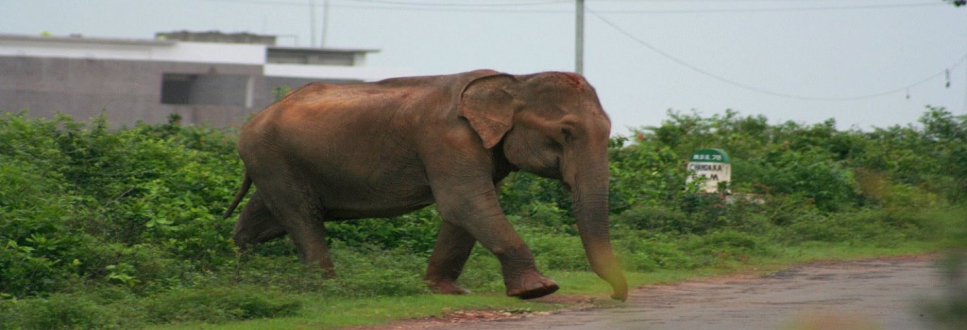Programs
Wild Tiger Conservation Program Wild Orissa’s Wild Tiger Conservation Program, started in 1997 is based on the spatial distribution of tigers in the forest areas of Orissa, their numbers and density and sex ratio, the potential areas where tigers have a brighter future, the existence of forest contiguity, etc. The question of laying emphasis on Orissa’s lost tigers was always there, keeping in view the fact after the Similipal forests were brought under the Project Tiger fold, tiger numbers there have stabilized, but elsewhere it was a matter of great concern at falling numbers. Based on these factors Wild Orissa had short listed Satkosia-Baisipalli and Sunabeda forests for its interventions for the first phase. The interventions were of the following order: - Undertaking field visits to the forests Carrying field surveys for the tiger and other animals Associating and coordinating with the State Forest Department during tiger census and in steps to conserve the tiger Briefing the press, media and the common person on the issues of tiger conservation Apprising elected representatives of the people on tiger conservation in earmarked areas like Satkosia-Baisipalli & Sunabeda Providing support to the lower rung of the forest staff employed in tiger areas Interacting with the local people and instill amongst them a desire to protect the tiger and the tiger forests without whose support tiger conservation would not be possible Studying the forest contiguity for ensuring a viable gene pool for wild tigers
Apart from Satkosia-Baisipalli & Sunabeda forests members from ‘Wild Orissa’ have participated in tiger/leopard censuses in many other forests in the state of Orissa, Similipal, Chandaka, Debrigarh, Kuldiha, Tangi, Ranpur, etc. Wild Orissa has been participating in the tiger censuses in the state of Orissa since 1997, organized by the Government Orissa, in a purely voluntary manner. Members of Wild Orissa travel into the deep forests to look for signs of the presence of tigers, Panthera tigris, and leopards, Panthera pardus, in the wild. The numbers of Tigers and Leopards have been enumerated in this manner at regular intervals.
The involvement of the members of Wild Orissa assists the organization in devolving plans and action points for the future tiger conservation initiatives at various levels. As per Wild Orissa’s Wild Tiger Conservation Programme surveys in remote forest areas have been carried out in the state. Such surveys have been carried out in the forest areas of Satkosia Gorge, Baisipalli, Sunabeda, Debrigarh, Phulbani, Berbera, Kotgarh, Ghumsur, Kalinga, Ushakothi, Nayagarh, etc. in the past. The surveys have thrown up excellent findings for charting out a course on tiger conservation in this state. In an attempt to draw the attention of various quarters and government departments on the need for more intensive tiger conservation efforts in the state of Orissa, for the first time in this state a National Symposium on “Conservation of Wild Tigers in Orissa” was organized by Wild Orissa during the early part of this year 2003. Representatives from all over the state as well as a few from the union government level attended the 2-day event inaugurated by His Excellency The Governor of Orissa. Many recommendations emerged after this event, some of the crucial ones being: - Biodiversity conservation in general and tiger and other endangered floral and faunal species in particular have been the driving force behind the creation of Protected Areas. Rich tiger habitats outside and away from Simlipal also should be brought under the umbrella of Project Tiger for execution of planned developmental activities and implementations with monitoring and evaluation. Specific recommendation is for immediate notification of “Satkosia –Baisipalli” (recently cleared by the Project Tiger Steering Committee) in central Orissa as a Tiger Reserve. Sunabeda Sanctuary harbours the second highest number of tigers after Simlipal, i.e. 24, in the state of Orissa. This patch of forests is contiguous with the Udanti-Sitanadi sanctuaries in Chhatisgarh through the Khariar forests, and with Udanti-Sitanadi having been cleared for inclusion under the Project Tiger scheme by the Steering Committee, there is an urgent need for placing the Sunabeda forests under the Project Tiger scheme. The specific recommendation in this regard is for immediate submission of proposal by the state government for Sunabeda. These contiguous patches are potential rich habitats for Hard Footed Barasingha and Wild Buffalo. Over the years, the Protected Area network has expanded to various forest types and biodiversity locations. The symposium focussed on the status of tiger population and potential areas needing priority for protection, conservation and improvement of habitat. It strongly recommends notifying the forests of ‘Narayanpatna’, Gupteswar, ‘Gandhamardhan’, ‘Kapilash’, ‘Malayagiri’ and ‘Chandrapur’ as sanctuaries. The contiguous forests of Baliguda, Kotgarh-Subarnagiri, Ghumsur, Boudh having a presence of 20 tigers, should be taken into consideration while formulating plans for any developmental activity in the region affecting forestland. The State Wildlife Advisory Board has not been convened for a long time. With the provisions of the Wildlife Protection Amendment Act in force, the ‘State Wildlife board’ should be expeditiously constituted for its functions. The second tiger crisis due to international demand for tiger skins, bones and other parts is looming large. There is need to establish a ‘Forensic Laboratory’ in Orissa for wildlife crimes. Further there is a need to establish State and District level Committees for collaboration and co-ordination with State and Central Enforcement agencies for intelligence sharing and for prevention and detection of wildlife crimes.
Up to date 49 members from the organization have associated with the state forest authorities in counting tigers from 1997 till date. Wild Orissa associated with the WWF-Tiger Conservation Program in its surveys in Satkosia-Baisipalli and Sunabeda-Khariar forests. Many hundreds of kilometers have been traversed on foot, and many nights have been spent in remote forest areas in the country by members from Wild Orissa in pursuit of tiger conservation. The campaign is on! |
|||||||||||||||
|







